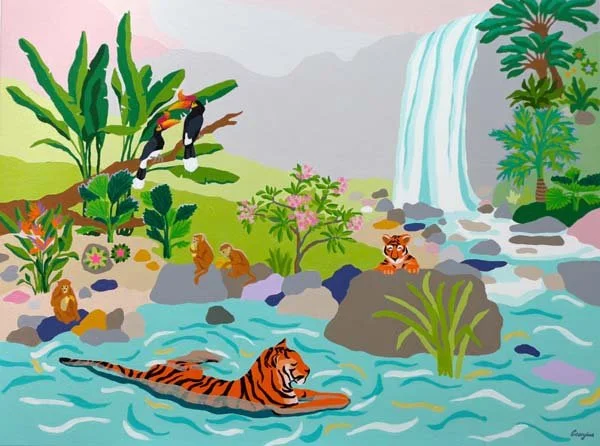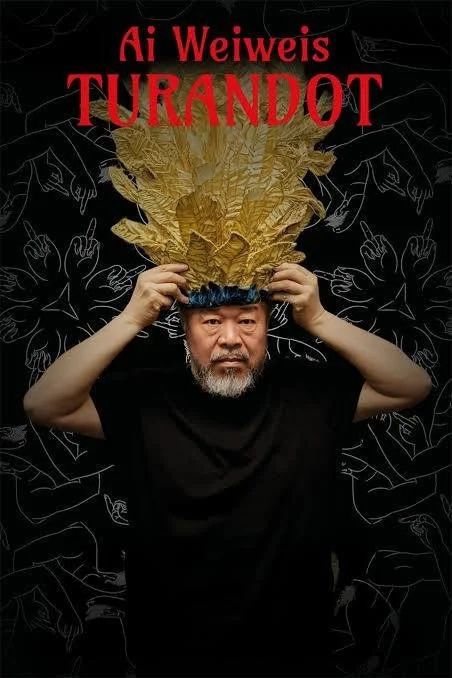Georgina Gray is a contemporary artist of British-Chinese descent and has lived most of her life in Singapore. She worked as an advertising writer for twelve years before deciding to pursue her childhood dream of becoming an artist. Inspired by travel and wildlife, her paintings of abstract landscapes and quirky animals in mad happy colours evoke a sense of fun and adventure, and provide a little lighthearted escapism from everyday life.
She is featured in the art book SITE.MA (Singapore in the eyes of mother artists) and two of her paintings were transformed into a collection by Singapore fashion label ANS.EIN. @georginagray_art
You were born in England and raised in Singapore, surrounded by both Western and Asian cultures. In what ways has this mix of influences shaped how you see—and make—art? I was born in England but have spent most of my life in Singapore. My father is British, and my mother is Malaysian Chinese, so I grew up immersed in both Western and Asian cultures. Living in the tropics has had a strong influence on my work. Singapore is a modern, fast-paced city, but it’s also incredibly lush with greenery and wildlife. That contrast often finds its way into my paintings, because I feel the need to counter the intensity of life here with art that is lighthearted and peaceful.
Do you remember the moment you knew art was going to be part of your life? I decided I wanted to be an artist or a writer at the age of nine. Although I studied art and graphic design in an art college, that part of my life was put aside when I entered the workforce as an advertising copywriter. It was only when I became a stay-at-home parent that I started picking up the paintbrush again.
Art became very important to me because my job as a writer was a creative one, and once I didn’t have that anymore, I needed another outlet to express myself.
Your studio sounds like a world of its own. Can you take us inside your process there? My studio is a small corner in my home—just a table, two easels, and a trolley filled with paint tubes, buckets, markers, and brushes. I work primarily with acrylics on canvas, and my process is quite organic. I don’t plan my paintings in detail; instead, I usually start with one main element—like a lemur on a swing—and build the scene around it, adding plants, flowers and other details as I go.
Each day begins with me doing rough sketches in a book, or staring at the blank canvas and pushing myself to make that first mark. But once I do, it’s happy days. Since I tend to use flat, opaque colours, I often need to apply multiple coats. My table is covered in repurposed takeaway sauce containers, which I use to store mixed paints and keep them from drying out. I try to work on at least two paintings at the same time so if I get stuck on one, I can get out of that mental block by working on the other.
What kinds of ideas or moods have been drawing you in lately? What are you working on right now? I am working on a series of seaside paintings that celebrate the simple pleasures in life. The twist is that instead of featuring people, the art will feature animals as a reminder that as people, we tend to get caught up in the hustle and bustle of life and forget to savour what comes so naturally to animals.
What do you hope people feel when they experience your art? What are you trying to express? In a word carefree!
Which artists, alive or dead, would you like to meet? I’d love to meet Jessie Breakwell from Australia. Her style feels really free and playful, which is something I’m drawn to. I think it would be amazing to chat with her about what inspires her and how she approaches her art.
I’m also a fan of Henri Matisse. I’ve always been fascinated by his use of colour and shape, especially in his cut-out works. There’s a simplicity and confidence in them that I really admire.
Do you draw inspiration from music, art, or other disciplines? I definitely draw inspiration from music. I believe an artist’s emotions can transfer directly onto the canvas, so I try to create in a calm or happy state of mind. Music can set the tone for that and I especially love listening to bossa nova while I paint.
The best thing about living in Singapore is the safety. You can walk around at night without worrying, and even issues like vandalism are rare. It’s something we tend to take for granted here.
Can you describe a project that challenged you creatively or emotionally—and how you worked through it? My series of black cat paintings came about quite unexpectedly. I had completely forgotten that I’d signed up for a postcard-sized art show—and suddenly, I had ten mini paintings due in just one week. I hadn’t even started. I needed to come up with something simple, but still true to my style.
Just then, as if on cue, my neighbour’s cat strolled over and curled up for a nap on our deck. While scrolling online for inspiration, I came across a lousy photo of a black cat. The image was so underexposed that all I could see was a dark blob with two bright eyes. And somehow, I absolutely loved it. That moment sparked the idea for a series of minimalist black cats—Slinky, inky shapes with big, round, innocent eyes, set against vibrant, playful backgrounds. The simplicity of the form allowed me celebrate the fluid grace of a cat's shape in a playful way—and most importantly, it was something I could complete in time for the show.
I met the deadline, and since then, I’ve gone on to create many more black cat paintings, in larger formats. What started as a last-minute scramble has turned into part of my artistic practice.
Tell us about important teachers/mentors/collaborators in your life. I've been fortunate to have lots of help along the way, starting with my supportive husband who also has a graphic design background and still assists me with the technical side of things.
My first art teacher was my mum, a talented Chinese brush painter. I was probably her most rebellious student, always wanting to do things my own way!
My two sons have also been a big inspiration. When they were young, I loved their drawings but noticed that they never wanted to colour them in. So I invited them to draw on a canvas, then added my own details and painted the colours in. We ended up creating a whole series together as ‘The Wongky Three’. Their wonderful imagination and creativity has definitely inspired me because my personal art style has also evolved to become more child-like and fun.
Most recently, I joined a community called Mama-on-Palette that champions mother artists. Through that, two of my works—'Summer Stroll' and 'Waterfall at Dusk'—were transformed into a wearable art collection by fashion designer Anseina Eliza of ANS.EIN. It was an amazing experience to see my art take on a whole new life in fashion.
Nature often appears in your work—lush, playful, peaceful. What role does the natural world play in how you create, or what you want to express? Nature is a central theme in my work, and much of my art celebrates the simple pleasures found in the natural world. I’m most inspired when I travel, and being in nature helps me slow down, be present and notice the little things—like the way light filters through leaves, for example. That sense of wonder finds its way into my work, especially in the colours I choose and the mood I try to create. My work is more about capturing a feeling than a place.
With AI reshaping so many creative fields, where do you stand on its role in the arts—and what’s at stake when the human touch is lost? I think AI is generally being used in the wrong way. It’s good for a laugh, like I’m really enjoying watching people asking Chat GPT to generate a human version of their pets. But it does alarm me when it is used as a cheap alternative to replace artists, illustrators and photographers. We should be using it to do the boring, mundane stuff that sucks up our time and energy, and not as a form of creative expression. It removes that human connection and that disturbs me.
Exploring ideas, art and the creative process connects me to…
life beyond the mundane.




















































































